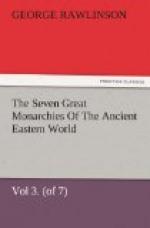Such, in outline, is the earliest phase of Arian religion, and it is common to both branches of the stock, and anterior to the rise of the Iranic, Median, or Persian system. That system is a revolt from this sensuous and superficial nature-worship. It begins with a distinct recognition of spiritual intelligences—real persons—with whom alone, and not with powers, religion is concerned. It divides these intelligences into good and bad, pure and impure, benignant and malevolent. To the former it applies the term Asuras (Ahuras), “living” or “spiritual beings,” in a good sense; to the latter, the term Devas, in a bad one. It regards the “powers” hitherto worshipped as chiefly Devas; but it excepts from this unfavorable view a certain number, and, recognizing them as Asuras, places them above the Izeds, or “angels.” Thus far it has made two advances, each of great importance, the substitution of real “persons” for “powers,” as objects of the religious faculty, and the separation of the persons into good and bad, pure and impure, righteous and wicked. But it does not stop here. It proceeds to assert, in a certain sense, monotheism against polytheism. It boldly declares that, at the head of the good intelligences, is a single great Intelligence, Ahuro-Mazdao, the highest object of adoration, the true Creator, Preserver, and Governor of the universe. This is its great glory. It sets before the soul a single Being as the source of all good and the proper object of the highest worship. Ahuro-Mazdao is “the creator of life, the earthly and the spiritual;” “he has made the celestial bodies, earth, water, and trees, all good creatures,” and “all good, true, holy, pure, things.” He is “the Holy God, the Holiest, the essence of truth, the father of all truth, the best being




